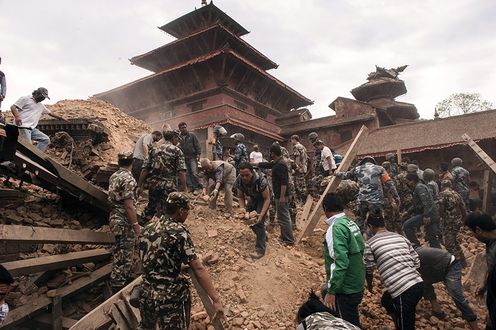
The 7.8 magnitude earthquake that hit Nepal on Saturday has awakened the world to the risks faced by the nation’s 26 million people.
Those of us who have had the pleasure of visiting Nepal cannot help but be struck by its vulnerability. Nepal, while spectacularly beautiful, is breathtakingly poor.
It is not hard to see at every turn how this spectacular country and its patient and tolerant people may be so susceptible to the impact of disasters.
Whether it is the visible cracks in ancient masonry, one of the world’s most dangerous roads linking Kathmandu to the tourist centre of Pokhara, or the tangled web of electricity cables wrapped around power poles.
Nepal’s unique geological environment, which has produced the world’s highest mountain range, the Himalayas, has also created geophysical hazards such as landslides, avalanches, flash flooding and glacial lake outbursts and particularly earthquakes such as the latest tragedy.
At the same time Nepal’s poverty has resulted in its population trying to secure a living along water ways or on mountain sides or in the densely populated capital city, Kathmandu.
The poverty of the country means that it lacks the resilient public health and community infrastructure that provide the protections necessary to ensure the health and well-being of its people.
Building standards are not well evident; not only in its ancient monuments but also among the more recent rapid construction that has followed population growth and urbanisation.
Vulnerable community
The impact that disasters have is a direct relationship between the extent of the hazard and the vulnerability of the community.
Nepal’s people are particularly vulnerable. An inadequate public health infrastructure cannot guarantee clean water, safe food or effective disposal of sewerage.
Health services already struggle to cope with daily demand and lack any capacity to surge in response to sudden increases in demand such as those associated with an earthquake.
Transportation systems rely almost entirely on a road infrastructure that is overloaded and unsafe. Population growth and urbanisation has led to overcrowding in the cities. Historically unsafe and inconsistent building standards result in a highly fragile built environment.
The mainstream media is reporting on the emerging impact this event has had on the people of Nepal. While there is a focus on the number of people who have died, there is likely to be many times that number who have suffered serious injury requiring urgent medical attention.
The evident struggle faced by Kathmandu’s health system does not yet reflect the total absence of medical care for those injured in remote communities who have still not been contacted.
The health risks to those remaining include the need for urgent medical and surgical care but also ongoing primary healthcare and hospital care for the normal health challenges of life from a system under extreme pressure.
Outside help
How can we help? Well firstly we need to find out what is needed by Nepal and consider how Australia may best render aid.
In the short term we should assist with securing the basics of life: water, food, shelter and medical care. Money is the most easily transportable aid that enables water and food to be secured either locally or through immediate neighbours.

Since the earthquake struck, many people are now sleeping in the open. We can help with temporary shelter by working with the World Health Organization (WHO), the United Nations (UN) and the Nepal government to provide temporary accommodation.
We should also be prepared to provide medical assistance, either in the form of medical supplies or through the provision of medical assistance teams. These teams will need to focus on primary care and public health although assistance with surgical care may be helpful.
Public health measures are critical to preventing outbreaks of infectious diseases that may necessarily follow the breakdown of the precarious public health protections that currently exist.
Rebuilding Nepal
In the longer term a more strategic and collaborative approach will be necessary to help rebuild the Nepalese economy and to assist with developing their public health infrastructure.
Building the public health infrastructure should focus not only on the basics of clean food and water, and sewerage disposal but also on supporting vaccination and community awareness programs. Effective health system development should be based initially on primary health-care supported by effective transport and retrieval services.
But the principal effort should be focused on building a stronger community. Poverty remains the greatest vulnerability and a world that genuinely cares will focus on helping Nepal build infrastructure that can help it leverage off its tourist potential.
Nepal also has a power potential thanks to the considerable range of heights above sea level – from more than 8,848m (Everest) down to 80m. It could enhance its use of hydroelectricity to help power its neighbours who also happen to be the world’s two most populous nations, India and China.
A safe community requires safe and reliable infrastructure, and the major benefit of that is to help Nepal build its economy and its social infrastructure. This will require strategic coordination led by Nepal but with the active and respectful support of the international community.
Gerard Fitzgerald does not work for, consult to, own shares in or receive funding from any company or organisation that would benefit from this article, and has no relevant affiliations.
